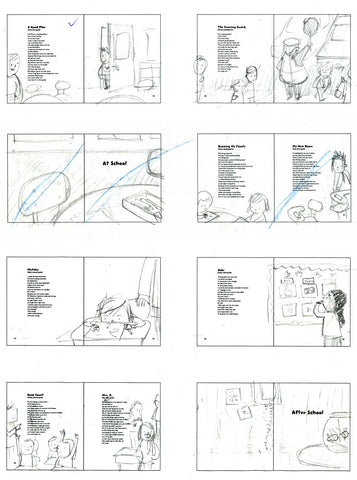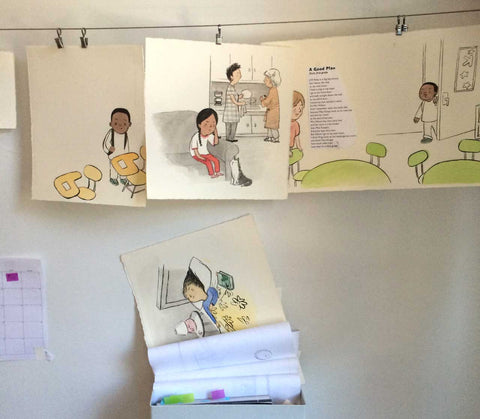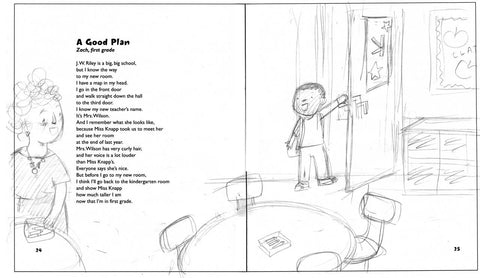Unabridged: a Charlesbridge Children's Book Blog — illustration

Painting A New School Year for Charlesbridge 0
Illustrator Mika Song discusses creating the illustrations for her new book A New School Year: Stories in Six Voices
When I first read Sally Derby’s poems in A New School Year I was struck by how familiar each character felt to me. My goal for the illustrations was to keep them simple and show the emotions in the poems.
I had been volunteering as a reading tutor, so kids and classrooms were already fresh in my mind. My agent sent me photos of her son’s preschool walls to give me ideas. The rest is from my own memories. Happily, schools haven’t really changed much since my childhood. Before I started working, Susan Sherman (Art Director at Charlesbridge) sent me pages with the poems already set in their places. It made it really easy to see the overall composition of each spread. I just added my drawings wherever they balanced well with the shapes of the poems and the white space.
Finally, I traced or just tried to copy the sketch onto watercolor paper for the final art. My favorite part of the process was mixing the different skin tones from the same three colors.
Watch a time-lapse of one of the characters (Mia) from Sally Derby’s A New School Year
Purchase A New School Year: Stories in Six Voices for your readers today!
- Mel Schuit
- Tags: A New School Year children's books illustration Mika Song

A Q&A with David Biedrzycki, Author of Groundhog's Runaway Shadow 1
We spoke with David Biedryzcki, the author of Groundhog's Runaway Shadow, about his inspiration and process behind writing and illustrating the book, just in time for Groundhog Day!
The idea of a runaway shadow is something that’s often played with in fiction. What drew you to this idea?
Initially, the idea for the story wasn’t at all about a groundhog. It was about a very boring person. His shadow one day decided it wanted more out of life than to just work in the quality control department of a Grass Seed Company watching grass grow.
As with most of my ideas, I started showing it in little bits during my presentations at school visits. The idea wasn’t resonating very well with students. I was thinking of shelving the idea for a while but one day after a presentation a student came up to me and suggested she’d like to see the main character as an animal. Bingo!
The story has a little more meat to it, too. It can also be read as a story about growing up, and staying friends even when you change. Why did you think this lesson was important for kids?
Good friends have much in common. But the friends I find the most interesting are the ones that are diverse and have different interests. Those are the friends I learn the most from.
Sometimes I might not totally agree with their points of view or beliefs, but deep down inside they are good people and good friends. They just have a different take on life than I do. I respect that and they respect me. I think sometimes that’s lacking in today's social media society, where a lot of people are spewing out their point of view and not taking time to listen or understand anyone else’s.
Groundhog’s Runaway Shadow works as an introduction to the tale of Groundhog Day. Did you originally think of this story with that in mind?
Well ,when that student suggested I have an animal as the main character, I immediately thought “groundhog,” with a different take on the story. Sometimes the groundhog sees his shadow and sometimes he doesn’t. So where is the shadow? Is his shadow still sleeping? Did his shadow run away? Why did it run away? Once I had that idea in place, the shadow became a character with it’s own wants and desires. I researched and found out that groundhogs by nature are very sedentary. They have a very limited palate: clover, tree bark and dandelions. Boring. But when the groundhog was little, he acted like a little kid, full of energy and fun. As he got older, though, he was expected to act a certain way. That’s when his shadow started having his own ideas.
Tell us a little about the process of writing and illustrating a book. Do the illustrations come first, or do the words? How do you work on both in harmony?
It has always been the drawing first. The drawings, for me, always plant the seed. I’ve always worked like that and probably will continue to create like that forever. I draw and then write the words. When I get stuck for words, I do more drawings. That’s my process.
Here are some drawings that inspired the beginning ideas for Groundhog’s Runaway Shadow.


- Alaina Leary
- Tags: children's books David Biedryzcki Groundhog Day Groundhog's Runaway Shadow illustration













